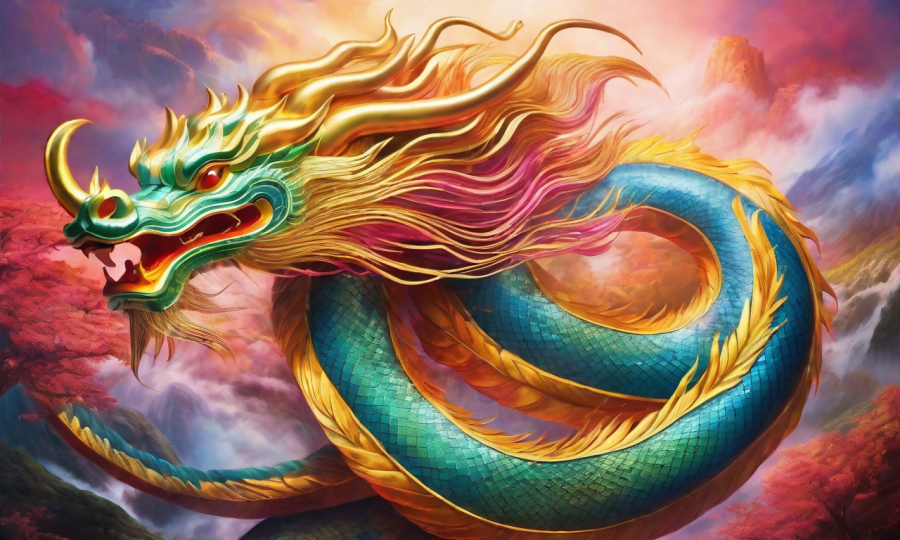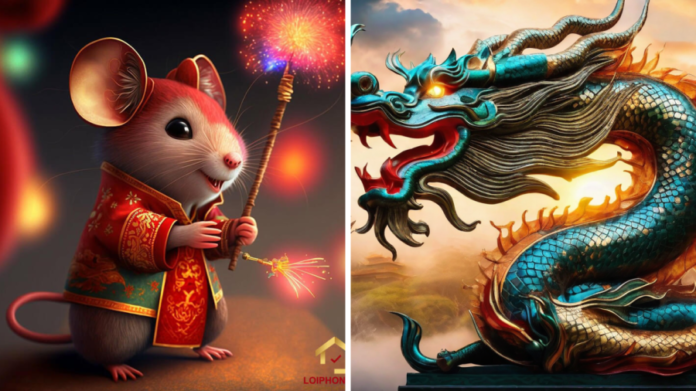In ancient times, the Chinese used the Twelve Earthly Branches to record the order of the years, known as the Heavenly Stems and Earthly Branches. During the Han Dynasty, the names of the Twelve Animals were combined with the Twelve Earthly Branches. The twelve animals were Rat, Ox, Tiger, Rabbit, Dragon, Snake, Horse, Goat, Monkey, Rooster, Dog, and Pig. These twelve animals represent the twelve Chinese zodiac signs and are used to record the year. Each year is paired with a Heavenly Stem and an Earthly Branch, which also connects the year of a person’s birth to the animal representing that year. This is used to predict the behavior, personality, and life of an individual. According to this belief, a person born in a specific year holds the characteristics of the animal representing that year.
The Rat is ranked first among the twelve zodiac animals. There are different explanations for this ranking. According to author Vương Hữu Quang in “Ngô Hạ Ngạn Liên,” the order of the zodiac animals is often questioned. He says, “The Pig is placed last, and the Dragon is near the end. The Rat is at the top. Who agrees with this? The Dragon is a divine creature, powerful like a tiger. It represents the atmosphere, yet it is placed below the Rat. Isn’t it contradictory?”
One explanation for the order is based on the habits and activities of the zodiac animals. According to the scholar Lý Trường Khanh of the Southern Song Dynasty, the Rat is most active during the hour of the Rat (11 p.m. to 1 a.m.) This is why the Rat is associated with this time period. The Ox is still chewing its food and preparing for an early morning farming session during the hour of the Ox (1 a.m. to 3 a.m.) The Tiger is searching for food in the forest during the hour of the Tiger (3 a.m. to 5 a.m.) During the hour of the Rabbit (5 a.m. to 7 a.m.), the sun has not yet risen, and the moon (Yin) is still shining bright, and the Jade Rabbit is grinding medicine. The Dragon is causing rain during the hour of the Dragon (7 a.m. to 9 a.m.) The Snake curls up in its den during the hour of the Snake (9 a.m. to 11 a.m.) The Horse roams the streets under a high sun during the hour of the Horse (11 a.m. to 1 p.m.)
During the hour of the Goat (1 p.m. to 3 p.m.), the Goat is eating grass. The Monkey is hopping around the forest during the hour of the Monkey (3 p.m. to 5 p.m.) The Rooster returns to its coop during the hour of the Rooster (5 p.m. to 7 p.m.) The Dog is alertly guarding the house during the hour of the Dog (7 p.m. to 9 p.m.) The Pig is sound asleep during the hour of the Pig (9 p.m. to 11 p.m.)
Another explanation is based on the concepts of Yin and Yang. The Twelve Earthly Branches are divided into Yin and Yang: Tý, Dần, Thìn, Ngọ, Thân, and Tuất belong to Yang, while Sửu, Mão, Tỵ, Mùi, Dậu, and Hợi belong to Yin. According to this, Yang is associated with odd numbers, and Yin is associated with even numbers. An interesting discovery is that the number of toes of the zodiac animals also follows the pattern of odd and even numbers.
The first person to propose this idea was Hồng Tốn, a scholar from the Song Dynasty. In his book “Dương Cốc mạn lục,” he categorized the zodiac animals into Yin and Yang: Rat, Tiger, Dragon, Monkey, and Dog have five fingers or toes and belong to the odd-numbered group. Ox, Rabbit, Goat, Rooster, and Pig all have four hooves and belong to the even-numbered group.
The cases of the Rat and Snake are exceptional. The Snake does not have legs, but its tongue is bifurcated, so it belongs to the even-numbered group. The Rat is the most unique case: It has four toes on its front legs (even) and five toes on its hind legs (odd). The hour of the Rat spans from the Yin hour before midnight to the Yang hour after midnight. Therefore, the Rat is associated with the hour of the Rat and is placed first among the twelve zodiac animals.
According to Chinese folklore, there is a story about the origin of the twelve zodiac animals. It is said that the Jade Emperor chose twelve animals to represent each year. During the ceremony to determine their positions in the zodiac, the Jade Emperor called out, “The largest animal should be the first, so the Ox should be at the front.” However, the Rat objected, claiming that people see it as more prominent and significant than the Ox.
To prove its point, the Rat and all the other animals went down to the mortal world to inquire. When the Ox passed by people, they only said, “This Ox is fat and healthy,” but they did not mention that it was large. At this moment, the Rat climbed onto the Ox’s back, stood up on its hind legs, and frightened the people, who exclaimed, “This Rat is so big!” This is how the Rat was chosen to be the first among the twelve zodiac animals.
In Chinese folk tales, the Rat is known to be cunning and crafty. It used its cunning tricks to secure the top position in the twelve zodiac animals.
In ancient times, when people relied heavily on agriculture, crops were destroyed wherever there were rats, and homes were damaged by rats. Even rice and grains were eaten by them. However, catching or eradicating rats was not an easy task because they were very smart. Therefore, rats were not favored and were considered the smartest among all the animals, placing them at the forefront of the twelve zodiac animals.








































